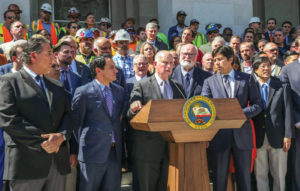
California passes law to spend $52.4 billion on infrastructure
Gov. Edmund G. Brown Jr. signed a package of legislation to improve transportation and create jobs in communities across California.
“Safe and smooth roads make California a better place to live and strengthen our economy,” said Gov. Brown. “This legislation will put thousands of people to work.”
SB 1, the Road Repair and Accountability Act of 2017, coauthored by Senator Jim Beall, D-San Jose, and Assemblymember Jim L. Frazier Jr., D-Discovery Bay, invests $52.4 billion over the next decade to fix roads, freeways, and bridges in communities across the state and put more dollars toward transit and safety.
“For too long we have neglected our state and local transportation needs,” said Assemblymember Frazier. “Our roads are falling apart and our bridges are in desperate need of repair. . . . Transportation is integral to our quality of life and SB 1 is the comprehensive funding package that will help repair our state highways and local streets and roads, while also expanding our travel options with funding for public transit.”
The legislative package will cost most drivers less than $10 a month and includes strict accountability provisions to ensure the funds can only be spent on transportation. The new funding will allow the California Department of Transportation (Caltrans) to make major repairs to California’s transportation infrastructure, including 17,000 miles of pavement, 500 bridges, and 55,000 culverts over the next ten years. The package will also fund huge investments in repairing local streets and roads. Additionally, the package provides historic levels of public transportation funding—roughly double what was provided by Proposition 1B in 2006.
The following funds will be split equally between state and local investments over a ten-year horizon:
Fix Local Streets and Transportation Infrastructure (50%):
- $15 billion in “Fix-It-First” local road repairs, including fixing potholes
- $7.5 billion to improve local public transportation
- $2 billion to support local “self-help” communities that are making their own investments in transportation improvements
- $1 billion to improve infrastructure that promotes walking and bicycling—double the existing funding levels
- $825 million for the State Transportation Improvement Program local contribution
- $250 million in local transportation planning grants
- Fix State Highways and Transportation Infrastructure (50%):
- $15 billion in “Fix-It-First” highway repairs, including smoother pavement
- $4 billion in bridge and culvert repairs
- $3 billion to improve trade corridors
- $2.5 billion to reduce congestion on major commute corridors
- $1.4 billion in other transportation investments, including $275 million for highway and intercity-transit improvements
EPA’s hydrologic evaluation of landfill performance (HELP) model
The U.S. Environmental Protection Agency’s (EPA) HELP model estimates water balances for landfills and other land disposal systems. The program models rainfall, runoff, infiltration, and other water pathways to estimate how much water builds up above each landfill liner. The model considers design parameters. It can incorporate data on vegetation, soil types, geosynthetic materials, initial moisture conditions, layer thicknesses, slopes, drain spacing, and liner placement.
A hydrological evaluation tool with many uses
Landfill closures: Use of the HELP model is required by the EPA to evaluate closure designs of hazardous and nonhazardous waste management facilities.
Design evaluation and permitting: More than 2,000 private engineering offices in a dozen countries use the model for landfill design evaluation and regulatory permitting actions. More than 200 offices of federal, state, and municipal governmental agencies use it for these purposes as well.
Training and research: This model is used for training and research at more than 50 universities.
Current model and a new version in production
The HELP model was developed for the EPA by the U.S. Army Corps of Engineers Waterways Experiment Station. This was done under a cooperative agreement with the EPA to support the Resource Conservation and Recovery Act (RCRA) and Superfund programs. The model applies to open, partially closed, and fully closed sites. Engineers can design landfill systems that include various combinations of vegetation, cover soils, waste cells, lateral drain layers, low permeability barrier soils, and synthetic geomembrane liners.
The model calculates daily, monthly, annual, and average annual estimates. It estimates amounts of runoff, evapotranspiration, drainage, leachate collection, and liner leakage.
HELP v3.5, a Microsoft Excel–based application, is being developed. This will replace HELP v3.07, a DOS application. A beta version of the new tool will be available soon.
Specifications
HELP v3.07, being a DOS-executable program, does not run in a Windows or macOS environment. The 16-bit program will not natively work with 64-bit systems (i.e., most Windows 7 and more recent systems). Therefore, a third-party emulator is required. Mac users should also search online for third-party applications to run DOS programs and to check compatibility with your version of macOS. To use a DOS emulator to install the HELP model, please follow the steps in “Walkthrough to Install and Operate the Hydrologic Evaluation of Landfill Performance (HELP) Model v3.07,” which can be found online at https://tinyurl.com/ycsp8apj.
 TEXTILES.ORG
TEXTILES.ORG


